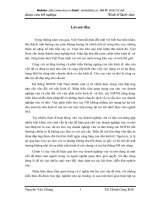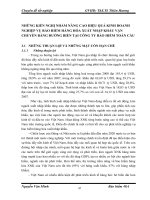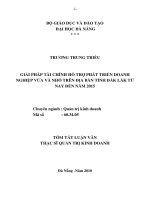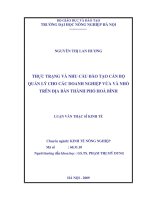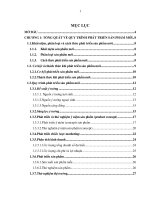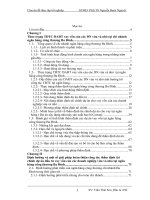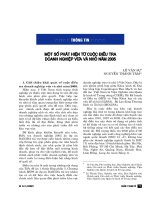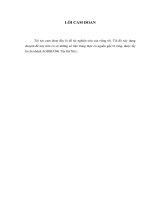tác động của quản trị nguồn nhân lực đến hoạt động sản xuất kinh doanh của các doanh nghiệp vừa và nhỏ trên địa bàn tỉnh tn tóm tắt tiếng anh
Bạn đang xem bản rút gọn của tài liệu. Xem và tải ngay bản đầy đủ của tài liệu tại đây (339.48 KB, 23 trang )
Southern Luzon State University
Republic of Philippines
IMPACT OF HUMAN RESOURCE MANAGEMENT PRACTICES
ON ORGANIZATIONAL PERFORMANCE IN SMALL AND
MEDIUM ENTERPRISES IN THAI NGUYEN CITY
A Dissertation
Presented to
The Faculty
Graduate School
Southern Luzon State University
Lucban, Quezon
In Partial Fulfillment
of the Requirements for the Degree
Doctor of Business Administration
by
LE KIM ANH (MAY)
2013
CHAPTER I
INTRODUCTION
Introduction
Human Resource Management is the process of developing, applying and
evaluating policies, procedures, methods and programs relating to the employment,
motivation, maintenance, and management of people in the organization. Human
resources management include activities like strategic HRM, human capital
management, corporate social responsibility, human resource planning, recruitment,
selection, training and development, reward management, performance management,
employee relations, health safety and employee well-being as well as provision of
employee services. It comprises a set of practices and policies designed to maximize
organizational integration, employee commitment, flexibility and quality of work
(Armstrong, 2009).
Over the years, researchers have suggested many HRM practices that have the
potential to improve and sustain organizational performance. These practices include
emphasis on employee selection based on fit with the company’s culture, emphasis on
behaviour, attitude, and necessary technical skills required by the job, compensation
contingent on performance, and employee empowerment to foster team work, among
others. Purcell et al., (2003) pointed out that the most successful companies had 'the big
idea', they had a clear vision and a set of integrated values. They were concerned with
sustaining performance and flexibility which reveals a clear evidence of positive attitudes
towards HR policies and practices, level of satisfaction, motivation and commitment, as
well as overall operational performance.
Background of the study
Small and Medium Enterprises (SMEs) have been recognized as important factor
of the economy of many countries and Vietnam is not an exception. According to the
data from the ministry of planning and investment of Vietnam SMEs occupied for nearly
85% of the total of enterprises in Vietnam and contribute nearly 45% of annual GDP of
the nation.
A significant amount of research has been conducted examining the relationship
between HRM and firm performance. In a recent review of the literature, Wright et al.,
(2005) found a total of 68 empirical studies looking at relationship between HRM and
some aspect of firm performance. The review focused specifically on published,
empirical studies testing a relationship between an HRM system and performance.
Notably, all of the review studies reported at least one significant relationship between
HRM system and performance. Clearly from this review of the literature, there is an
increasing agreement that a relationship does exist between HRM and firm performance.
For all the reasons above, the researcher would like to conduct the study: “Impact
of Human Resource Management Practices on Organizational Performance in Small and
Medium Enterprises in Thai Nguyen City”
Statement of problems
This study aimed to analyze the “Impact of Human Resource Management
Practices on Organizational Performance in Small and Medium Enterprises in Thai
Nguyen City”. Specifically, it sought to answer the following questions
1. What is the profile of the enterprises, in terms of:
1.1. Types of enterprise;
1.2. Form of owner ship;
1.3. Time of operated; and
1.4. Amount of employees?
2. What are the SMEs’s HR practices as to:
2.1. Recruitment and Selection;
2.2. Training and Development;
2.3. Career Planning System;
2.4. Participation and Involvement;
2.5. Compensation and benefits; and
2.6. Performance Appraisal?
3. What are the perceptual SMEs’s managers in organizational performances?
4. What are the effects of these HR practices on the financial performance of
SMEs?
Hypotheses
H1. Recruitment and Selection positively effects SME’s performance.
H2. Training and Development positively effects SME’s performance.
H3. Career Planning System positively effects SME’s performance.
H4. Participation and Involvement positively effects SME’s performance.
H5. Compensation and Benefits positively effects SME’s performance.
H6. Performance Appraisal positively effects SME’s performance.
CHAPTER II
REVIEW OF LITERATUES AND RELATED STUDIES
Roles of SMEs in the economy
European Commission stated in the Recommendation 2003/361/EC in 2003 that
SMEs play a central role in the European economy. They are a major source of
entrepreneurial skills, innovation and employment. In the enlarged European Union of 25
countries, some 23 million SMEs provide around 75 million jobs and represent 99% of
all enterprises. SMEs are the engine of the European economy. They are an essential
source of jobs, create entrepreneurial spirit and innovation in the EU and are thus crucial
for fostering competitiveness and employment.
Measures of the Human Resource Management System
One of the long recognized limitations in the SHRM is the lack of a clear
definition of the HR System construct. Qualitative and meta-analytic review of the
literature reveals considerable variability in how the HR System construct is defined and
measured (e.g. Arthur & Boyles, 2007; Boselie et al., 2006). Arthur and Boyles (2007)
provide a useful discussion of this issue and propose a framework for more clearly
defining HR System constructs.
Human Resource Principles
HR Principles are conceptualized as organization leaders’ general view of the
strategic importance of their human assets. Early work by McGregor (1960) delineates
two basic attitudinal orientations of managers regarding their employees and two
corresponding managerial approaches. The first, Theory X suggests a managerial
attitude that employees are generally unmotivated and largely incapable of self-directed
behavior. These attitudinal assumptions imply that employees are largely disposable and
interchangeable and manifest operationally in management approaches characterized by
rigid hierarchies, narrowly defined jobs and a command and control management. This
is consistent with the Tayloristic approach referenced earlier.
Human Resource Programs
Objective reports of HR programs by a key organizational informant, is the most
common conceptualization of the HR system construct. Three general classes of items
have been used to measure HR Programs: 1) simple dichotomous “yes or no” responses
regarding the existence of the program (e.g. Huselid, 1995); 2) Likert scale items asking
the degree to which the respondent agrees that a certain practice is in place (e.g. Bae &
Lawler, 2000); and 3) more objective reports of raw percentages of total employees
covered by the program or, in the case of training, the number of hours an employee
spends in training over some period of time (e.g. Huselid, 1995).
Human Resource Practices
HR Programs and HR Practices are similar in that they seek to measure the
existence and use of various HR programs. However, they differ in that they seek this
information from different sources. These source characteristics have important
implications on the properties of the construct (Arthur & Boyles, 2007).
Human Resource Perceptions
Here, as with the distinction between HR Programs and HR Practices, we have
another conceptually distinct measure focused specifically on employee interpretations of
HR Practices.
Impact of Human Resource Management to firm performance
Recent academic research has attempted to demonstrate the impact of HRM on
firm performance and the relationship between the practices and firm outcomes is
discussed best in the strategic human resource management literature (Pfeffer, 1998;
Rogers & White, 1998).
Recruitment and Selection (R&S)
According to Bratton and Gold (2007, page 239), recruitment is ‘the process of
generating a pool of capable people to apply to an organization for employment’ and
selection is ‘the process by which managers and others use specific instruments to
choose from a pool of applicants the person(s) most likely to succeed in the job(s),
given management goals and legal requirements. Companies using a good selectivity in
the hiring process ensure getting the right skilled and qualified people for the right job
(Pfeffer, 1994; Huselid, 1995). According to Koch and McGrath (1996), there exists
a positive relationship between HR recruitment and selection and labor productivity.
Training and Development (T&D)
Companies intending to gain a sustained competitive advantage should help their
employees raise their skills by receiving continuous training so that they can learn new
things need to ensure quality improvement of the products and services of the
company.
In organizations the training remains a major activity of Human Resource
Development (HRD) practice (Nordhaug, 1989) for employee development and their
competencies building (Gritz, 1993). To perform effectively, at a managerial position,
employees go through dynamic process of training and development (Baldwin &
Padgett, 1994).
Career Planning System (CPS)
Career Planning and Development Program, fostering organizational
effectiveness, depends on the organization’s ability to transfer staff from a
conventional model of expectation to one of increased responsibility for their own
career growth and development (Martin, Romero, Valle & Dolan, 2001).
Participation and Involvement
“Coming together is a beginning, Keeping together is progress, Working together
is success” Henry Ford
Ford & Randolph (1992) said that Management Style, where subordinates
contribute extensively in decision making with their leaders is Participatory
Management. Strauss (2006) said that participation is a process that allows employees to
exercise some control over their work and the conditions under which they work.
Performance Appraisal
The measurement of employees’ performance allows the company to provide
compensation fairly to the deserving individuals according to certain predetermined
criteria like employee competency, teamwork ability, initiative, soft skills and ethics
Compensation and Benefits
Bratton and Gold (2007, page 358) state that reward refers to ‘all of the
monetary, non-monetary and psychological payments that an organization provides
for its employees in exchange for the work they perform’. Motivating employees through
a good reward system constitutes a difficult and challenging task for general managers as
it can positively affect employees’ behavior toward their jobs and increase their
commitment and thus their performance.
Perceived Organizational Performance (POP)
In literature, various indicators of organizational performance have been used,
perceptual measures of organizational performance were used by Delany & Huselid
(1996) financial measures such as profit and financial ratios were used by Terpstra &
Rozell (1993) the value added or sales of the organization per employee were
applied by Black & Lynch (2001) and Cappelli & Neumark (2001) and physical
measures of organizational productivity were used by Arthur (1994).
Financial Organizational Performance (FOP)
Greer (2001) examined financial performance of the companies and HRM
practices, exploring the significant relationships between the variables. Huselid (1995)
studied 968 US organizations to explore the use of high performance work practices and
found that productivity was influenced by employee motivation; financial performance
was influenced by employee skills, motivation and organizational structures. Return on
Asset (ROA) and Return on Equity (ROE) are frequently used to measure financial
performance by different researchers i.e. Delery & Doty (1996) and Snell & Youndt
(1995).
Return on Equity (ROE)
Financial performance is given by the ROE (net profit / equity, in book value).
This indicator is very important for shareholders. However, the ROE does not permit
assessment of the profitability of all invested funds. Return on equity (ROE) is repeatedly
used to determine financial performance by HRM researchers Delery & Doty (1996) and
Snell & Youndt, (1995). This ratio is used to determine how many times the company
earned with respect to shareholders equity.
Return on Assets (ROA)
ROA is an indicator of how profitable a company is in relation to its total assets.
ROA gives an idea as to how efficient management is at using its assets to generate
earnings. Dividing a company's annual earnings by its total assets, ROA is calculated in
percentage. Sometimes this is referred to as "return on investment".
Conceptual Framework
Independent Variables
SMEs’s HR practices as to:
+ Recruitment and
Selection
+ Training &
Development
+ Career Planning
+ Participation and
Involvement
+ Compensation and
benefits
+ Performance
Appraisal
ANALYSIS
Dependent Variable
ORGANIZATIONAL
PERFORMANCE
+ Perceived Organizational
Performance
+ Organizational Finance
CHAPTER III
RESEARCH METHODOLOGY
Locale of the Study
The study was conducted June 2013 in Thai Nguyen City, which is situated in the
Far North-East of Vietnam and surrounded by Bac Kan Province on the north, Tuyen
Quang and Vinh Phuc provinces on the west, Lang Son and Bac Giang provinces on the
east, and Hanoi on the south.
Population, Sample Size and Sampling Technique
The population was composed of 2040 small and medium enterprises (SMEs),
local in Thai Nguyen city, Thai Nguyen Province. The sample population was
determined using the Slovin’s formula with a 5% margin for sampling error, the sample
size derived was 334 respondents. The respondents were selected using random sampling
technique sourced, however only 290 questionnaire were collected.
Description of Respondents
The main respondents are managers of the small and medium-sized enterprises in
Thai Nguyen City.
Statistical Treatment
Items
Methodology
Data
I. Profile of respondents
Frequency Count, Percentage
Survey
II. Respondents’ perception
Weighted Mean, ranking
Survey
III. Reliability
Exploratory factor
analysis
Coefficient
alpha
CHAPTER IV
PRESENTATION ANALYSIS AND INTERPRETATION OF DATA
4.1. Reliability
At initial stage coefficient alpha (Cronbach, 1951) was applied. Data was
analyzed to measure reliability. The study computed separate and combined reliability
estimates, which are similar to the normally used coefficient alpha statistics.
Cronbach value beyond (α = 0.7) signifies acceptable reliability (Cuieford, 1965).
Inter item consistency reliability or Cronbach’s alpha reliability coefficients of
one dependent, one mediating and six independent variables were obtained, they all were
above (α = 0.70). Cronbach’s alpha calculated. As the coefficients get closer to (α = 1.0)
the better is reliabilities and coefficients, and less than (α = 0.60) are considered poor.
Recruitment & selection was measured by 10 items and had a Cronbach’s alpha of
(α = 0.766), training & development scale contained 10 items with (α = 0.821)
Cronbach’s alpha value, Career planning system was measured through 10 items and had
Cronbach’s alpha of (α = 0.808), Participation and Involvement was measured through
10 items with Cronbach’s alpha of (α = 0.848), compensation and benefit was also
measured by 10 item scale with Cronbach’s alpha (α = 0.815), Performance appraisal
scale contained 10 items with (α = 0.776) Cronbach’s alpha and the dependent variable
perceived organizational performance was also measured by 10 items scale with
Cronbach’s alpha value of (α = 0.742).
4.2. The relationship between Human Resource Management practices and
perceived organizational and financial performance
Table 4.2.1. Variables Included in Analyses
1
RS
Recruitment and Selection
2
TD
Training and Development
3
PA
Performance Appraisal
4
CP
Career Planning System
5
PI
Participation and Involvement
6
CB
Compensation and Benefits
7
OP
Organizational Performance
8
ROA
Return on Asset
9
ROE
Return on Equity
Correlation results are shown in Table (4.2.2). Correlations amongst variables are
positive. Correlation interpretation is based on following five classical rules introduced
by Franzblau (1985) to interpret correlation coefficient amongst different variables,
(r = 0 to 0.20) indicates negligible or no correlation
(r = 0.20 to 0.40) indicates positive but low degree of correlation
(r = 0.40 to 0.60) indicates positive moderate degree of correlation
(r = 0.60 to 0.80) indicates positive and marked degree of correlation
(r = 0.80 to .1.00) indicates positive and high degree of correlation
All variables are treated symmetrically, i.e. there is no distinction between
dependent and independent variables. Two variables are said to be correlated when they
tend to simultaneously vary in the same direction. If both the variables tend to increase
or decrease together, the correlation is said to be direct or positive. When one variable
tends to increase and the other decreases, the correlation is said to be negative or inverse.
Table 4.2.2. Descriptive Statistics
Range
Minimum
Maximum
Mean
Std. Deviation
POP
4.00
1.00
5.00
3.80
0.90
ROE
6.40
-1.94
4.46
0.26
0.59
ROA
1.63
-1.27
0.36
0.0366
0.150
RS
4.00
1.00
5.00
3.20
0.85
TD
4.00
1.00
5.00
3.32
0.85
CP
3.00
2.00
5.00
3.05
0.85
PI
2.00
3.00
5.00
3.10
0.86
CB
2.00
3.00
5.00
3.02
0.83
PA
4.00
1.00
5.00
3.21
0.85
Valid N (list wise) 290
Standard deviation is the balancing point for the distribution. It serves as a basic
measure of variability. Smaller value of the standard deviation indicates that most of the
observations in a data set are close to the mean, while a large value implies that the
observations are scattered widely about the mean. Table (4.2.2) is showing standard
deviation and means values of different variables. For POP (Mean = 3.80, S.D =
.90), for RS (Mean = 3.20, S.D = .85), for TD (Mean = 3.32, S.D = .85), for CP (Mean =
3.05, S.D = .86), for PI (Mean = 3.10, S.D = .86) and for CB (Mean = 3.02, S.D = .83),
for PA (Mean = 3.21, S.D = .85). All these values are indicating that there is a minute
difference between answers given by HRM executives. A generic argument can be
developed on the basis of small value of standard deviation and high value of
mean are indicative of respondents, agreement with the options for all the
questions asked from respondents.
Table 4.2.3. Correlations Amongst Variables
POP
ROE
ROA
RS
TD
PA
CP
PI
CB
POP
1
ROE
052
1
ROA
.081
.001
1
RS
.351(**)
.01
022
1
TD
.250(**)
003
.057
.423(**)
1
PA
.334(**)
.027
034
.331(**)
.446(**)
1
CP
.274(**)
.059
058
.378(**)
.350(**)
.423(**)
1
PI
.302(**)
108(*)
.015
.337(**)
.327(**)
.370(**)
.355(**)
1
CB
.220(**)
.043
037
.198(**)
0.053
.220(**)
.256(**)
.412(**)
1
**Correlation is significant at the 0.01 level (1-tailed).
*Correlation is significant at the 0.05 level (1-tailed).
Table (4.2.3) contains correlations for all variables and Table (4.2.2) contains
descriptive statistics comprising upon values of standard deviation, mean, median, modes,
minimum maximum values and range. There is positive correlation amongst
independent variables and dependent variable perceived organizational performance. (r =
0.351, p < 0.01) correlation of recruitment and selection with perceived organizational
performance with mean (3.2) and standard deviation (S.D =0.85) is indicating that there is
positive and significant correlation between these two variables, proving that standardized and
transparent selection system is part of organizational performance indicators. Furthermore
R&S insignificant correlation with ROE and ROA. (r = .025, p < .01) correlation of Training
and Development with perceived organizational performance showing mean (3.32) and
standard deviation (S.D = .85) indicates that training will be beneficial for individuals and
organizations when conducted after training needs analysis. Training conducted in this
fashion will ultimately increase the efficiency of the organization. Secondly it indicates
that training should focus on what the present job demands are in terms of desired Attitude,
Skill, and Knowledge (ASK) rather than on those (ASK) that are somewhat connected
to the current job. While (r = .423, p < .01) is the highest value of correlation of Training
and Development with Recruitment and Selection indicating that whenever there is a highly
scientific and rigorous selection system, where line managers and HRM managers both
participate in selection, valid and standardized tests are used for the selection of those who
have desired knowledge, skills and attitudes, then training creates a more positive effect,
otherwise training may not be a productive activity.
Performance appraisal is showing correlation (r = .334, p < .01, mean = 3.21 and
S.D = .85) with perceived organizational performance indicating that performance of those
employees will be good who have been selected through standardized procedures with the
right caliber and combined opinion of different concerned managers. Correlation (r = .446,
p < .01) between performance appraisal and training is the highest proving that training
based on the needs identified through appraisal has a better fit. Training needs identified
from performance evaluation process, considering the opinion of all concerned stakeholders
as realistic and useful. Correlation (r =.331, p < .01) with recruitment and selection is
indicating that PA is positively linked with RS. The significant association between
performance appraisal and organizational performance reflects the psyche of the SMEs in
Thai Nguyen city that the performance of the employees is measured on the basis of
quantifiable results. The appraisal system in these organizations can be growth and
development oriented, if, the employees of the organizations are provided with
performance based feedback and counseling. Employees have more faith on the
performance appraisal system and the appraisal system will have a strong influence on the
individual and team behavior.
Career planning (r = .274, p < .01, Mean = 3.05 and S. D = .85) with perceived
organizational performance are presenting positive and significant relationship. When
organizations focus on career planning their employee performance and perceived
organizational performance is enhanced. Furthermore (r =. 378, p < .01) with recruitment &
selection, (r = . 350, p <.01) with training & development and ( r = . 423, p < .01) with
performance appraisal also indicate the same direction.
Compensation and Benefit correlation (r = .220, p < .01, mean = 3.02 and S. D = .83)
with Perceived organizational Performance. (r = .198, p < .01) with recruitment &
selection, ( r = . 220, p< .01) with performance appraisal, ( r = . 256, p < .01) with career
planning ( r = .412, p < .01) with employee performance shows that the compensation system
will be acceptable and satisfactory when it is linked with the performance shown in the
performance appraisal process. In a nutshell, the results show that the usage of pay based on
merit and performance and matching with the expectations of employees leads to higher
employee and organizational performance.
Participation and Involvement (r = .302, p < .01, mean = 3.10 and S. D = .86) with
Perceived organizational Performance and (r = .337, p < .01) with recruitment & selection, (r
= .327, p < .01) with training & development, (r = .370, p < .01) with performance appraisal
and (r = .355,p < .01) with career planning show positive relationships. These results are
indicating that SMEs in Thai Nguyen city are moving steadily towards employee
participation approach. It indicates that among individual HRM practices, employee
participation in routine decision making and sometimes in strategic decision making, is
also a very important factor which leads the organizations to a relatively high
performance. It also indicates that the employees in the organizations are allowed
to make decisions related to cost and quality matters. They are asked by their supervisors to
participate in operation related decisions. Finally they are provided with an opportunity to
suggest improvements in the way things are being done.
Highest mean of Training & Development (3.32) is indicating that majority of the
managers think that T&D is the most important factor in organizational performance,
but compensation benefit is showing the lowest mean (3.02), indicating that the
compensation system already prevailing in the organizations is not as much of a focused
factor as compared to other HRM practices. There are some correlation values that are
positively correlated with ROE and ROA but none of them is significant.
CHAPTER V
SUMMARY, FINDINGS, CONCLUSIONS AND RECOMMENDATIONS
From the output presented in the preceding chapter, the Researcher presents the
summary, findings, conclusions and recommendations sought in this study.
5.1. Summary
The study was conducted to assess impact of human resource management practices
on the organizational performance of the small and medium enterprises in Thai Nguyen
Province. A total of 290 managers and staffs of the small and medium-sized enterprises in
Thai Nguyen City were selected to be the respondents of the study. It specifically explored on
the profile of the respondents in terms of Types of enterprise; Form of owner ship; Time of
operated; Number of employees. The study was limited to determine the perception of the
respondents on the human resource practices of the small and medium enterprises in Thai
Nguyen City which are classified in aspects namely: Recruitment and Selection; Training and
development; Career planning System; Participation and Involvement; Compensation and
Benefit; and Performance appraisal.
The 290 selected respondents were given a questionnaire designed by the researcher
and complete the questionnaires after being explained and instructed by the researcher. The
researcher floated the questionnaire to the respondents after it had been validated by her
advisor in June 2013.
5.2. Findings
From the analysis and interpretation of data, the followings are summarized.
5.1.1. The Profiles of Respondents
The major of SMEs is trading enterprise, the represented for 131 company and
accounted for 45.2% of the total respondents participated in this study and ranked at the top;
The majority of SMEs are limited enterprise, they represented for 130 respondents,
accounted for 44.8%;
The majority of SMEs have length of business from 6 to 10 years, they represented for
111 respondents, accounted for 38.3%, and corresponding to the top rank.
The majority of SMEs have total labour form 31 to 50, they represented for 88
respondents, accounted for 30.3%, and corresponding to the top rank.
With respect to Recruitment and Selection
Most of SMEs in Thai Nguyen when they do Recruitment and selection always had
line managers and HR managers participate so that the indicator “In our organization, line
managers and HR managers participate in recruitment & selection” got the highest overall
mean of 3.69 (SA), while the indicator “Selection system in our organization selects those
having the desired knowledge, skills and attitudes” got the lowest mean (2.88 – N) that mean
in SMEs in Thai Nguyen, they did not usually got right person who have desired knowledge,
skill and attitudes.
Recruitment and selection, based on well-defined merit and unprejudiced system
developed through managerial expert opinions, using standardized test to scrutinize the exact
required attitude, skills and knowledge in potential candidates showed notable significant
correlation with Perceived Organizational Performance that identification of the right
candidate with required skills to perform the job for achieving organizational performance is
the output of sophisticated selection system.
With respect to Training and Development
With regard to Training and Development, the assessment of respondents have
indicator “There are formal training evaluation methods to assess the effectiveness of the
training” got highest mean (3.79 – SA)” and the lowest mean “Trainings need identified are
realistic, useful and based on the organizational strategy”
That meaning that Training and development programs in organizations based on
training need assessment, performance appraisal, customization and practically applicable
with skills imparting capability because T&D positive correlation and Perceived
Organizational Performance.
With respect to Career Planning System
For assessed Career Planning System, most of respondents aware about their career
ladder at each level in our organization (3.64 – SA). However Employees at each level in their
organization have not always clear career ladder (2.43 – DA), that mean most of the SMEs
not had clear career ladder.
A perception that the Career Planning System (CPS) is significantly correlated with
Perceived Organizational Performance (r = 0.274, at level 0.001) is true if, the Career
Planning System is based on clear career ladder, aligned goals with organizational vision,
used for succession planning, transparent internal hiring, and equal unambiguous employment
opportunity.
With respect to Participation and Involvement
In SMEs most of respondents had liberty to organize their job tasks as per their
convenience so that they could produce more output (3.29 – N) while employee indicated that
they had culture that promotes employee involvement in our organization and always are
asked by superiors to participate in related decisions, however employee of at level not always
gave a change to take part decision making process up to an extent. (2.85 – N).
Employee participation related to decision-making process based on opportunities to
make company and self-related decisions, suggestion collection for the betterment of
organization and employee wellbeing as also on appreciation strategy has significant positive
correlation with perceived organizational performance.
With respect to Compensation and Benefits
Compensation offered by SMEs matches the expectancy of employees (3.59 – SA)
and salary and other benefits are comparable to the market (3.24 – A) and in very important
that the compensation for all employees is directly linked to their performance. The data
showed compensation and benefits is positively correlated with perceived organizational
performance.
With respect to Performance Appraisal
There is a significant relation between Perceived Organizational Performance and
performance appraisal system, that seems based on focused used modern appraisal system
with latest techniques and technology for bonuses, promotions and selected training.
Employee assessed appraisal system of SMEs had a strong influence on individual and team
behavior and, however in SMEs some of employee not knows clear objectives of performance
appraisal
5.3. Conclusions
This study is an addition to earlier research efforts in understanding the relationship
between organizational performance and HRM practices. The study provides new dimensions
in the research of management by opening a debate on the importance of HRM practices in
organizational performance. Statistically significant correlations and regression results were
indicated that different HRM practices, such as recruitment and selection, training and
development, performance appraisal, employee participation, career planning system and
compensation system are significantly related and make positive contributions towards
perceived organizational performance.
SMEs in Thai Nguyen having transparent selection systems, adequately scheduled
training programs and employee participation in decision-making are high performers. These
organizations become attractive for local and foreign investors for further investment that
contributes considerable growth in the economic activities in Thai Nguyen. Since the
employee performance is contributing the mediating role between HRM practices and POP,
hence the motivating HRM practices can enhance their performance that increases company
performance.
5.3. Recommendations
SMEs in Thai Nguyen city interested in their development and growth ought to adopt
transparent procedures for recruitment and selection of human resource on competency basis.
Similarly, for creating high level of organizational commitment and company ownership with
high quality service and productivity, the comprehensive training and development programs
need to be arranged to update employee skills for meeting the challenges of contemporary
competitiveness. Organizational performance needs appropriate employee handling so that
they stay in the company. It needs a suitable career planning system.
Compensation is the reward for which majority of the people work. If it is paid on time,
on merit and comparable with market packages, then it makes employees feel happier and
they contribute more.
The study indicated that the organizations that make use of effective HRM practices on
a wider scale generate higher performance.
SMEs in Thai Nguyen City should establish a process of identifying Return on
Recruitment & Selection System (RORS), Return on Training & Development system
(ROTD), Return on Career Planning System (ROCP), Return on Performance Appraisal
System (ROPA), Return on Employee Participation system (ROEP), and Return on
Compensation system (ROC).
SMEs in Thai Nguyen City should think about launching a proper procedure for
monitoring the implementation of HRM practices to gain higher performance.
SMEs in Thai Nguyen City should also consider designing HRM practices with focus
on employee performance.
